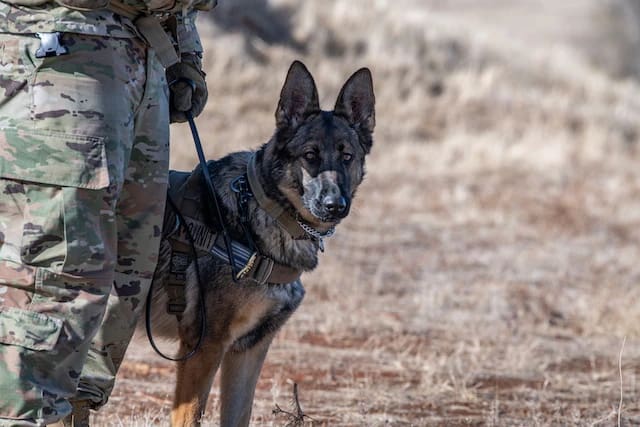JOINT BASE SAN ANTONIO-LACKLAND, Texas (AFNS) —
The Air Force Security Forces Center-led Government Working Dog Category Intelligence Team aims to improve the cost, process and procurement of government working dogs across 14 federal agencies.

The team recently submitted the Working Dog Category Intelligence Report, which looked into the requirements of maintaining working dogs within the Department of Defense, Department of State, Department of Homeland Security and the Department of Justice, in an effort to identify gaps and opportunities, recommend more effective and efficient sourcing strategies, close gaps between current practices and share government and industry best practices.
Scott R. Heise, team lead and director of Air Force Security & Protection Category Management’s Program Management Office for AFSFC, said “The report identified some crucial gaps, such as the procurement process.”
“All of us have the same need for working dogs, but the way we source them is very different,” Heise said. “Even our requirements are different and this inconsistency makes it difficult for the vendors to try to keep up and maintain a supply of high-quality working dogs. Simple things, like the age of the dog or the type of socialization it gets prior to delivery, present challenges for the vendors.”
“If all the agencies give vendors one integrated demand forecast, then the vendors can develop a better plan to meet our needs and satisfy the demand,” Heise added.
“The improved procurement process will allow Air Force Defenders the ability to better manage their MWD programs, making them healthier and stronger at the tactical, operational and strategic levels,” said Master Sgt. Steven Kaun, AFSFC Military Working Dog program manager.
“This streamlined process will pair up more canines with more handlers across the Air Force and allow garrison, and even up to combatant commanders, to have more assets on hand to accomplish their missions,” Kaun said. “And it also helps give some of our older, hard-working dogs a much deserved, timely retirement.”
In addition to the procurement process, the report provided six recommendations to improve the GWD program:
1. Establish an annual purchase forecast to both the contiguous United States and outside-CONUS vendors, which will help with the breeding and preparation process
2. Implement acquisition best practices to guide agencies during the procurement process
3. Provide the Customs and Border Protection Agency opportunities to work with OCONUS vendors, which will give the agency more options to source working dogs
4. Establish a small business breeder communication plan to help develop a larger U.S. vendor base
5. Build standardized U.S. government-wide working dog travel requirements for airlines
6. Develop a national emergency response plan for explosive detection working dogs
“What we expect from these recommendations is continued growth and maturation of the working dog program not only for the Air Force, but all 14 agencies,” Heise said. “We also see great potential to build the U.S. industrial base for government working dogs and ensure the participation of small businesses, and advance the goals of category management.”
Category management is an approach the federal government is implementing to help standardize procurement functions and share best practices across its agencies in the hopes of providing savings, better value, and efficiency. It is divided into 10 categories.
The AFSFC originally started a Category Intelligence Report on the Air Force-led DoD Military Working Dog program, but Heise saw opportunities to look beyond the services and include other federal agencies.
“Once we started, we saw how closely TSA worked with DoD on Lackland AFB, so I recommended to the Federal Category Manager that we make the CIR a government-wide effort,” Heise said. “She agreed and assigned me as the Government-wide Working Dog Team lead for the Security and Protection category.”
The newly-formed multi-agency team then researched and presented the six recommendations in the final Category Intelligence Report to Jaclyn Rubino, the government-wide Security & Protection Category manager. Rubino approved all recommendations and teams will now be assembled to create a category execution plan for each.
“This is the Air Force’s first interagency category management and Category Intelligence Report effort, and it’s an honor to be part of the team that will not only bring change to the Air Force, but other federal agencies as well,” Heise said. “I feel it speaks to the Security Forces Center’s mission, but on a larger, cross agency scale – to train, equip and manage program execution and provide expertise, and drive integration, innovation and advancement of Security Forces mission sets.”
Story by By Malcolm McClendon, Air Force Installation and Mission Support Center Public Affairs
Photo by Airman 1st Class Jason W. Cochran


Why doesn’t the USAF Guard have a take home dog program for their cops (excuse me, “Defenders”).
The dogs could be TDY short notice and tasked to various DOD and LE support positions on an as needed basis. Obviously it would require oversight, but there is no Posse Comitatus with the Guard, and certainly not with a dog. This isn’t a new concept, we have a massive amount of PDs with working dogs where the dog is taken home.
If the USAF is already handling this due to their known dog prowess, bump Master Sgt. Steven Kaun up to an E8 slot and sic him (pun intended) on a larger program.
I can think of at least one USAF Col working out of the Pentagon (TPS) who is ready for a star and could take on a multi disciplined program with MIL / LE and FED interaction. I would bet that in short time the program would go multi-national as well.
Off the top of my head, I can’t think of any US agency who has more time working MWDs in such a wide variety of roles and foreign lands than the USAF (giving them props where due). Attack dog, dope dog, tracking dog, SAR & CSAR, bomb or whatever else you can come up with, I’m sure the USAF K9 program has done it.